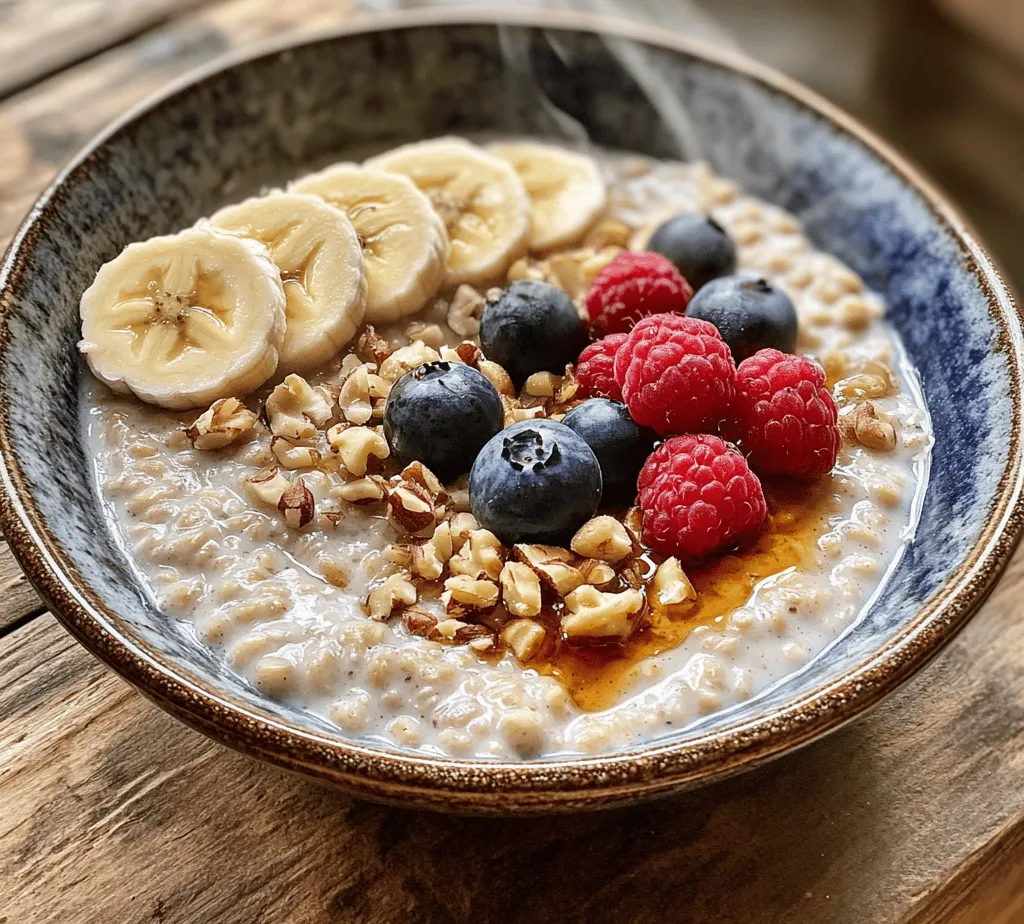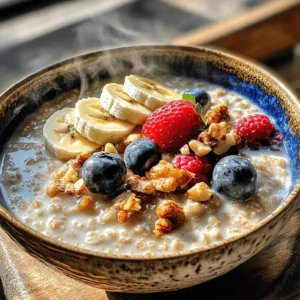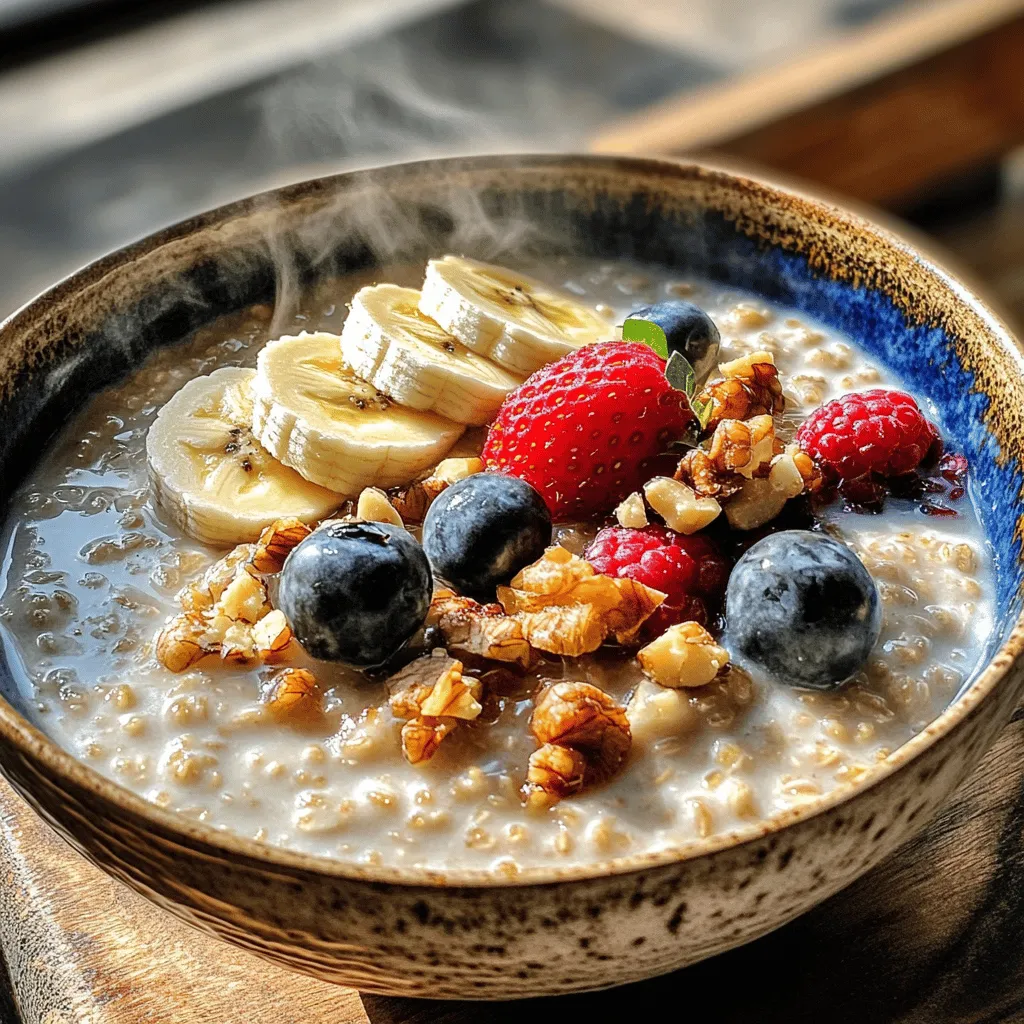Introduction
Barley is gaining recognition as one of the most nutritious grains available, and rightly so. Often overlooked in favor of more commonly used grains like wheat and rice, barley offers a wealth of health benefits that make it an excellent choice for breakfast. Among the many delightful ways to enjoy barley, a warm bowl of barley porridge stands out as a comforting start to your day. This hearty dish not only nourishes the body but also warms the soul, making it an ideal choice for chilly mornings or when you crave something soothing.
Breakfast is often touted as the most important meal of the day, and for good reason. It provides the fuel needed to kickstart your metabolism and sustain your energy levels throughout the morning. Incorporating barley porridge into your breakfast routine can elevate your meal with its unique flavor, texture, and array of nutrients. This recipe is not only wholesome but also incredibly versatile; you can customize it based on your preferences, dietary needs, or what you have on hand. Whether you prefer it sweetened with a drizzle of maple syrup or topped with fresh fruits and nuts, barley porridge can be tailored to suit any palate.
In this article, we will explore the health benefits of barley porridge, provide a detailed breakdown of the ingredients, and guide you through the step-by-step process of making this delightful dish. Get ready to embrace the wonderful world of barley and discover a new breakfast favorite that nourishes both body and mind.
Understanding Barley
Nutritional Profile of Pearl Barley
Pearl barley, the most common form of barley used in cooking, is a whole grain that boasts an impressive nutritional profile. It is an excellent source of dietary fiber, which is essential for digestive health and can help regulate blood sugar levels. In addition to fiber, pearl barley is rich in vitamins and minerals, including B vitamins, iron, magnesium, and selenium. This nutrient-dense grain is low in fat and calories, making it a heart-healthy option that can help you feel fuller for longer.
One of the standout features of pearl barley is its high soluble fiber content, which can aid in reducing cholesterol levels and improving heart health. Just a half-cup serving of cooked pearl barley contains about 3 grams of fiber, contributing to your daily recommended intake. This makes it a smart choice for those looking to enhance their diet or manage their weight.
Comparison Between Pearl Barley and Other Grains
When compared to other popular grains, pearl barley holds its own. For example, oatmeal is often celebrated for its health benefits, but pearl barley offers a unique set of advantages. While both grains are high in fiber, barley tends to have a lower glycemic index than oatmeal, which means it can be a better choice for those managing blood sugar levels.
Quinoa, another healthful grain, is known for its complete protein profile. However, barley is still a formidable contender when it comes to nutrition. It provides a good balance of carbohydrates and protein, making it a satisfying option for breakfast. Additionally, barley is often more affordable than quinoa, making it an accessible choice for those on a budget.
Historical Significance and Culinary Uses of Barley
Barley has a rich history that dates back thousands of years. It is one of the oldest cultivated grains in the world, with evidence of its use found in ancient civilizations across the Middle East, Asia, and Europe. Historically, barley was a staple food for many cultures and was often used in breads, soups, and stews. It also played a significant role in brewing, as it was one of the primary ingredients in beer production.
In modern culinary practices, barley is making a resurgence as a versatile ingredient. While it can be found in many traditional dishes, such as risottos and salads, barley porridge is a delightful way to enjoy this grain’s unique texture and flavor. Its adaptability allows it to shine in both savory and sweet applications, making it a fantastic addition to your cooking repertoire.
Ingredients Breakdown
To create a delicious bowl of barley porridge, you will need a few key ingredients. Each component plays a crucial role in enhancing the flavor, texture, and nutritional value of the dish.
Pearl Barley: What It Is and Its Health Benefits
As mentioned earlier, pearl barley is the star of this recipe. Unlike hulled barley, which retains its bran and germ, pearl barley undergoes a polishing process that removes the outer layer, resulting in a softer grain. This makes it quicker to cook while still providing a nutty flavor and chewy texture.
The health benefits of pearl barley are numerous. It is an excellent source of antioxidants, which help combat oxidative stress in the body. The high fiber content not only aids in digestion but also promotes heart health by lowering cholesterol levels. Additionally, pearl barley contains essential vitamins and minerals that support overall well-being.
Water or Vegetable Broth: The Role of Liquid in Cooking Grains
The liquid you choose to cook your barley porridge can significantly impact the final flavor of the dish. While water is a straightforward choice, using vegetable broth can add depth and richness to the porridge. Broth infuses the barley with savory notes that enhance its natural flavor, making for a more satisfying bowl of porridge.
When using broth, opt for low-sodium options to control the salt content in your dish. If you are making a large batch, consider preparing your own vegetable broth at home using leftover vegetables and herbs for a fresh and flavorful base.
Salt: Importance of Seasoning in Enhancing Flavor
Salt may seem like a simple ingredient, but it plays a vital role in cooking grains. Adding a pinch of salt to your barley porridge not only enhances the overall flavor but also balances the sweetness of any toppings you may add later. It is crucial to season your grains properly to bring out their natural taste.
For this recipe, a small amount of salt is all you need. Remember, you can always adjust the seasoning later, so start with a little and taste as you go.
Butter or Olive Oil: Comparison of Flavors and Health Aspects
One of the delightful aspects of barley porridge is the option to enrich it with healthy fats. You can choose to add butter for a creamy richness or olive oil for a lighter, more Mediterranean flavor. Both options have their merits:
– Butter adds a decadent creaminess that makes the porridge feel indulgent. It also provides a good source of fat-soluble vitamins, such as vitamins A, D, E, and K.
– Olive oil, on the other hand, is a staple of the Mediterranean diet and is known for its heart-healthy monounsaturated fats. It imparts a fruity flavor that complements the nuttiness of barley beautifully.
The choice between butter and olive oil ultimately depends on your personal preference and dietary needs. You can even experiment with both to see which you enjoy more!
Milk: Nutritional Value and Alternatives (Dairy vs. Plant-Based)
Adding milk to your barley porridge can elevate its creaminess and provide additional nutrients. Dairy milk is a rich source of protein, calcium, and vitamin D, making it a popular choice for many. However, if you are lactose intolerant or prefer plant-based options, there are plenty of alternatives to choose from.
– Almond milk offers a light flavor and is low in calories, while still providing a hint of nuttiness.
– Coconut milk can add a tropical flair with its creamy texture and sweet taste.
– Oat milk is another excellent option that pairs well with the natural flavor of barley, providing a smooth and creamy porridge.
When selecting a milk alternative, be sure to choose unsweetened varieties to control the sugar content of your dish.
Sweeteners: Maple Syrup vs. Honey – Flavor Profiles and Health Considerations
Sweetening your barley porridge can transform it from a simple breakfast into a delightful treat. While there are several options for sweeteners, maple syrup and honey are two popular choices, each with its unique flavor profile and health considerations.
– Maple syrup adds a rich, caramel-like sweetness that pairs beautifully with the nuttiness of barley. It is a source of antioxidants and contains minerals such as manganese and zinc, making it a healthier option than refined sugars.
– Honey, on the other hand, provides a floral sweetness and has been used for centuries for its potential health benefits, including its antibacterial properties. However, honey is not suitable for vegans, so consider your dietary preferences when choosing a sweetener.
Both sweeteners can be used interchangeably, so feel free to experiment with what you have on hand or what you prefer!
Ground Cinnamon: Not Just for Flavor, But Also Its Health Benefits
Cinnamon is more than just a tasty spice; it also boasts numerous health benefits. This warm and aromatic spice has been linked to anti-inflammatory properties and may help regulate blood sugar levels. Its distinctive flavor complements the earthy notes of barley wonderfully, making it a perfect addition to your porridge.
When choosing cinnamon, consider using Ceylon cinnamon, also known as “true cinnamon,” for its superior flavor and lower coumarin content, which can be harmful in large quantities. A sprinkle of ground cinnamon can elevate your porridge to a whole new level of deliciousness.
Fresh Fruits and Nuts/Seeds: Adding Color, Texture, and Nutritional Value
Finally, to finish off your barley porridge, consider adding a variety of fresh fruits, nuts, or seeds. These toppings not only enhance the appearance of your dish but also add vibrant colors, textures, and a nutritional boost.
– Fruits such as berries, bananas, or apples provide natural sweetness and are packed with vitamins, minerals, and antioxidants.
– Nuts and seeds, like almonds, walnuts, or chia seeds, contribute healthy fats, protein, and crunch, making your porridge more satisfying.
Feel free to mix and match your toppings based on what’s in season or what you enjoy most. The options are endless, allowing you to create a unique bowl of barley porridge every time.
Step-by-Step Instructions
Now that you have a good understanding of the ingredients and their benefits, it’s time to dive into the cooking process. The first step in making your comforting barley porridge is to rinse the pearl barley. Rinsing is crucial for several reasons:
– Remove impurities: Rinsing helps eliminate any dust, debris, or residual processing materials that may be present on the grains.
– Improve texture: This step can also help remove excess starch from the barley, leading to a less gummy and more pleasant texture once cooked.
– Enhance flavor: By rinsing, you allow the natural flavors of the barley to shine through, resulting in a more enjoyable dish.
To rinse your pearl barley, place it in a fine-mesh strainer and run it under cold water for a minute or two. Gently stir the barley with your fingers to ensure that all grains are cleaned thoroughly. Once rinsed, allow the barley to drain while you prepare the other ingredients.
Stay tuned for the next part of this article, where we will continue with the step-by-step instructions for cooking your barley porridge to perfection. Enjoy this nourishing dish that will surely become a staple in your breakfast rotation!

Cooking Process: Detailed Breakdown of Boiling, Simmering, and Stirring
To create the perfect bowl of barley porridge, the cooking process is fundamental. Start by rinsing your barley grains under cold water to remove any dust or impurities. This simple step enhances the flavor and ensures a cleaner end product.
1. Boiling: In a medium-sized pot, combine the rinsed barley with water or your choice of plant-based milk. A good ratio to follow is 1 part barley to 3 parts liquid. Bring the mixture to a boil over medium-high heat. The boiling process activates the starch in the barley, which is essential for that creamy texture we’re aiming for.
2. Simmering: Once the mixture reaches a rolling boil, reduce the heat to low. Cover the pot with a lid, allowing the barley to simmer gently. This slow cooking method is key to achieving tender grains. Stir occasionally to prevent the barley from sticking to the bottom of the pot. Simmer for about 30 to 40 minutes, or until the barley is soft and has absorbed most of the liquid.
3. Stirring: As the barley cooks, you’ll notice a transformation. Once it becomes tender, give it a good stir. This not only helps to distribute heat evenly but also releases more starch, resulting in a smoother porridge. If you prefer a thicker porridge, continue to cook until the desired consistency is reached, adding more liquid if necessary.
Adjusting Consistency: How to Know When the Porridge is Just Right
Achieving the right consistency in your barley porridge is essential for a satisfying dish. The ideal porridge should be creamy and slightly thick, but not overly dense. To confirm that your porridge is just right, consider the following tips:
– Visual Cues: The porridge should have a glossy appearance, indicating that the starch has been released adequately. It should flow easily when stirred but hold its shape when portioned.
– Texture Test: Take a spoonful and let it sit for a moment. If the porridge clumps together but is still pourable, you’ve hit the sweet spot. If it seems too runny, let it simmer a bit longer, stirring frequently.
– Tasting: The best way to determine doneness is, of course, to taste it. The barley should be tender, with a slight chew, but not mushy. Adjust the cooking time based on your personal preference for texture.
Serving Suggestions: Creative Ways to Present and Enjoy Barley Porridge
Barley porridge is not just nutritious; it’s also incredibly versatile. Here are some creative serving suggestions to elevate your breakfast experience:
1. Fruit and Nut Bowl: Top your porridge with fresh fruits like sliced bananas, berries, or apples. Add a handful of nuts or seeds—such as almonds, walnuts, or chia seeds—for a satisfying crunch.
2. Sweet Delights: Drizzle natural sweeteners like maple syrup or honey over your porridge, or stir in a spoonful of nut butter for added creaminess and flavor. A sprinkle of cinnamon or nutmeg can enhance the sweetness and aroma.
3. Savory Twist: For a savory option, consider adding sautéed vegetables, a poached egg, or even a sprinkle of cheese. This transforms your porridge into a hearty lunch or dinner dish.
4. Smoothie Style: Blend the cooked porridge with a little extra milk and frozen fruits for a smoothie bowl. Top with granola and coconut flakes for a refreshing twist.
Health Benefits of Barley Porridge
Incorporating barley porridge into your diet comes with a myriad of health benefits, making it a wise choice for breakfast or any meal of the day.
– High Fiber Content and Its Effects on Digestive Health: Barley is rich in soluble fiber, which aids in digestion and promotes a healthy gut. The fiber helps to regulate bowel movements and can prevent constipation, making it an excellent choice for digestive health.
– Impact on Heart Health and Cholesterol Levels: Consuming barley regularly has been linked to lower cholesterol levels. The beta-glucans found in barley can help reduce total and LDL cholesterol, decreasing the risk of heart disease.
– Benefits of Using Plant-Based Milk and Natural Sweeteners: By opting for plant-based milk, you can lower saturated fat intake while increasing the nutritional value of your porridge. Natural sweeteners like honey or maple syrup provide flavor without the artificial additives found in many processed sugars.
– Importance of a Balanced Breakfast for Maintaining Energy Levels: Barley porridge is a fantastic source of complex carbohydrates, which provide sustained energy throughout the day. This balanced meal can help you feel full longer, reducing the need for unhealthy snacks.
Variations and Customizations
Barley porridge is not only nutritious but also an excellent canvas for culinary creativity. Here are some variations and customizations to consider:
– Exploring Different Flavor Profiles: Spice up your porridge by incorporating warm spices such as nutmeg, ginger, or cardamom. These spices not only add depth of flavor but also come with their own health benefits.
– Incorporating Seasonal Fruits and Toppings: Utilize seasonal fruits to keep your porridge fresh and exciting. In the summer, try peaches or cherries; in the fall, consider adding pumpkin puree or roasted apples.
– Making It Vegan or Gluten-Free: Barley itself is not gluten-free, but you can easily make this porridge vegan by using plant-based milk. For gluten-free alternatives, consider substituting barley with quinoa or a gluten-free grain blend.
– Ideas for Savory Variations: Transform your porridge into a savory dish by adding sautéed greens, roasted vegetables, or spices like turmeric and cumin. This could easily serve as a hearty lunch or light dinner.
Cultural Significance of Porridge
Porridge has a rich history and cultural significance across the globe. Different cultures have their unique recipes and traditions surrounding this comforting dish.
– How Different Cultures Around the World Enjoy Porridge: In many cultures, porridge is a staple food. For instance, in Scotland, oatmeal porridge is commonly served with salt and cream, while in China, congee is enjoyed both sweet and savory.
– Traditional Recipes and Methods Related to Barley and Other Grains: Barley is used in various traditional dishes worldwide, from Middle Eastern stews to Eastern European soups. Each culture has its method of preparation and serving, showcasing the grain’s versatility.
– The Role of Porridge in Breakfast Traditions Globally: Porridge is often considered a comfort food, representing warmth and nourishment. Its presence in breakfast traditions signifies its importance as a source of energy and sustenance to start the day.
Conclusion
Barley porridge stands out as a comforting and nutritious dish that offers a wealth of health benefits. Its high fiber content supports digestive health, while its heart-healthy properties make it an excellent choice for those looking to improve their overall wellness. With endless possibilities for customization, from sweet to savory, barley porridge can adapt to any palate or dietary preference.
We encourage you to try making this recipe and experience the warmth and nourishment that comes from a bowl of barley porridge. As you incorporate barley into your diet, explore other recipes and discover the versatility of this ancient grain. Whether you enjoy it as a breakfast staple or a hearty meal, barley porridge will undoubtedly become a beloved addition to your culinary repertoire.



